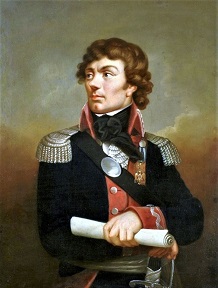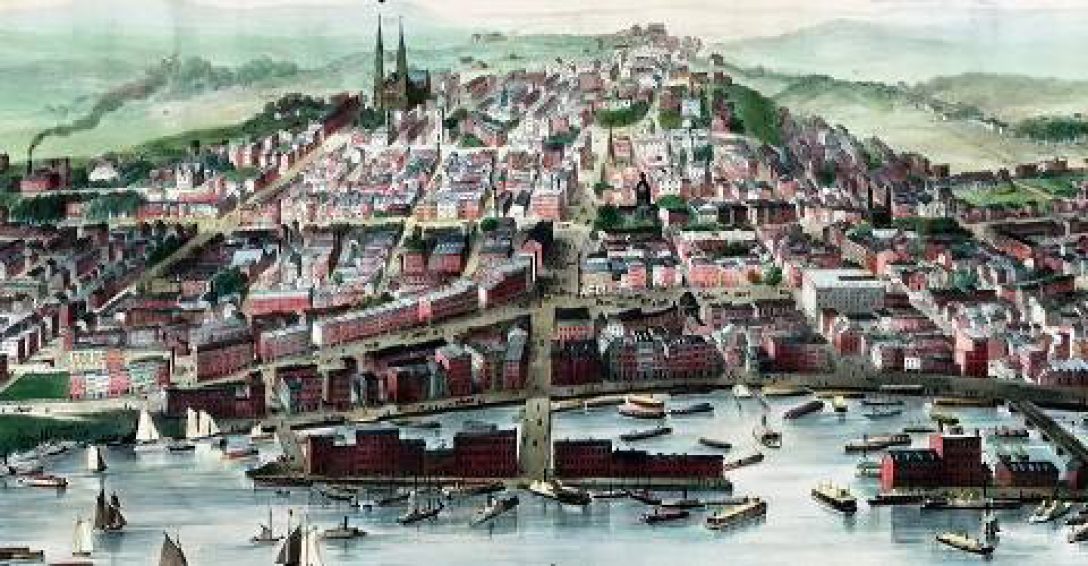
The Polish guy is Thaddeus Kościuszko a Polish/Lithuanian immigrant and a largely unsung hero of the American Revolution. The Bridge, connecting Albany and Saratoga Counties, commemorates a remarkable man who played a critical role, serving as an engineer, in the American victory at the Battle of Saratoga, the “turning point” of the Revolution.
He was an extraordinary man, a citizen of the world, who fought for the rights and liberty of all men and women against the tyranny of oppressive governments and institutions. (He found slavery of any kind, from African-Americans to feudal peasants in Europe, a particularly malignant evil.)
Act I – Early Life
Kosciuszko was born in 1746 in a small village, the youngest son of a poor noble family. He received training at the royal military academy and became an Army captain. Shortly thereafter a civil war arose in his country – his brother fought for insurgents; rather than take sides, Kosciuszko emigrated to France. He wanted to join the French Army, but couldn’t because he wasn’t French, so he enrolled in the Royal Academy of Fine Arts and Sculpture in Paris. In his spare time he studied in the libraries of the French military academies, learning economics, engineering, and military science. After 5 years he returned to home, but found there was no place in the Army for him. Ultimately he returned to Paris, where he learned about the nascent American Revolution.
Act 2 -The American Revolution
In 1776 Kosciuszko appeared one day at the print shop of Ben Franklin in Philadelphia (everyone, even the French, knew about Franklin). Franklin spent time with the young man, assessing his abilities and sent him off with a letter of introduction to the Continental Congress. Congress gave him an appointment as a colonel in the Continental Army and his work began – building fortifications around and near Philadelphia and along the Delaware River.
In summer 1777 he went north with General Horatio Gates, Commander of the Northern Department of the Continental Army, to Albany and then on to Fort Ticonderoga. Kosciuszko proposed placement of a battery on higher ground, on Sugar Loaf Mt. (now Mt. Defiance), overlooking the Fort; his recommendation was ignored. Subsequently the Fort was lost to General Burgoyne and the British army who laid siege, using the higher ground to their advantage. The Americans abandoned the Fort, slipping away using a flotilla of small boats and an ingenious floating log bridge of Kosciuszko’s design.
As the Americans fled, Albany’s own General Philip Schuyler adopted a “scorched earth” policy to cover the American escape and delay Burgoyne’s Army. Kosciuszko led the effort to destroy bridges and causeways, dam streams to cause flooding and fell trees. He was then ordered to survey the area north of Albany to find the best site to build defensible fortifications against the British. He selected Saratoga and began construction of defenses that proved impenetrable. Burgoyne was forced to surrender. General Gates, said after the battle “…the great tacticians of the campaign were hills and forests, which a young Polish engineer was skillful enough to select for my encampment.”
After Saratoga, Kosciuszko was dispatched to improve fortifications at West Point. (Benedict Arnold was going to pass Kosciuszko’s plans to Major Andre.) He remained at West Point until he requested a transfer to the Southern Army in 1780 where the battle for the country had moved. Again, Kosciuszko distinguished himself through his brilliant engineering skills and his bravery.
In 1783 he was appointed Brigadier General, granted American citizenship and given property. By now he was 37, a man of middle age at the time. But the remarkable life of Thaddeus Kosciuszko had only just begun. The next year he returned home to Poland.

Act 3 – Back to Poland and the Kościuszko Uprising
In the late 1780s he was appointed a Major General in the Army. Kosciuszko joined his country’s reform movement that produced the first Constitution in Europe. But the democratic ideals were viewed as a threat to the surrounding feudal countries. In 1792, the Russian army (with help from the Prussians) invaded. Kosciuszko proved a brilliant military strategist, winning several great battles against formidable Russians troops. But ultimately the king surrendered to the army of Catherine the Great and Kosciuszko and other members of the Resistance fled.
Biding his time, Kosciuszko planned how to free his country. Several years later Kosciuszko led troops determined to oust the Russians. After a number of great victories Kosciuszko was wounded, captured by the Russians and taken to St. Petersburg. (The uprising was soon over.) Ultimately he was pardoned by Tsar Paul, who also agreed to release 20,000 Polish freedom fighters (and gave him some money) if he took a loyalty oath and agreed never to return to Poland. (Later Kosciuszko tried to return the money when he renounced the oath; the Tsar refused to accept it.)
Act 4 – Back to America
After his release Kosciuszko returned to Philadelphia, catching up with old friends, collecting his back military pay and forming a lasting friendship with then Vice-President Thomas Jefferson*. It appears he meant to remain in America, but events on the other side of the Atlantic intervened. He learned his nephews and other Poles were fighting in France under Napoleon and the new French government of the Revolution was seeking his support in taking the fight to the Prussians occupying his beloved Poland. He was eager to go to Europe, but concerned he could be a target of the new Alien and Sedition Act (1798) which could be used strip him of his American citizenship and prevent his re-entry into the U.S. (This was an era of un-declared hostilities between America and France.) Jefferson secured Kosciuszko a false passport and he left for France as a secret envoy. He later wrote: “Jefferson considered that I would be the most effective intermediary in bringing an accord with France, so I accepted the mission even if without any official authorization.”
Act V -Return to Europe
By the time Kościuszko arrived in June 1798, plans had changed. While involved in Polish émigré circles in France, he refused command of Polish troops serving with the French. He had several testy meetings with Napoleon; there was mutual dislike. Kościuszko withdrew from political and military life to the French countryside, not being permitted to leave France.
Years later when Napoleon did reach Poland Kosciuszko mistrusted his intentions and refused an alliance. After Napoleon was deposed Tsar Alexander I approached him, trying to broker a political deal involving Russian control of part of Poland. Kosciusko demanded political and social reforms which the Tsar was not willing to grant. Kosciuszko finally went to live in free Switzerland where he remained until his death in 1817. (Just before his death he freed the serfs on his remaining Polish land; the Tsar undid the emancipation.)
A great life well-lived in the defense of ideals freedom and equality for all.
*Upon leaving America, Kosciuszko wrote a will leaving his American property to Jefferson in order to purchase the freedom of slaves and to educate them. After Kosciuszko’s death in 1817, Jefferson said he was unable to act as executor. The case of Kościuszko’s American estate went three times to the U.S. Supreme Court. The Court eventually ruled that the property belonged to Kosciuszko’s heirs in the 1850s.
“I Thaddeus Kosciuszko being just in my departure from America do hereby declare and direct that should I make no other testamentary disposition of my property in the United States I hereby authorise my friend Thomas Jefferson to employ the whole thereof in purchasing Negroes from among his own or any others and giving them liberty in my name, in giving them an education in trades or otherwise and in having them instructed for their new condition in the duties of morality which may make them good neighbours, good fathers or mothers, husbands or wives and in their duties as citizens teaching them to be defenders of their liberty and Country and of the good order of society and in whatsoever may make them happy and useful and I make the said Thomas Jefferson my executor of this. T. Kosciuszko 5th day of May 1798”
~ Last Will and Testament
Copyright 2021 Julie O’Connor

